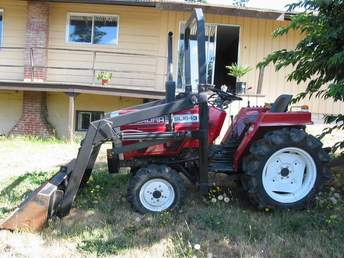vettespeed
New User
I"m a real tractor rookie and just wanted something small to do a
little work around my .75 acres which is partially on a grade. I found
a real nice Shibaura SL1643 (19hp, 1500 lbs, 4WD) w/loader that I
thought would work nicely. I got it home and before I even got near the
steepest area of the property I damn near tipped it over. It seems to
have a loader that is a little too large for the tractor (5 ft. wide)
which puts a lot of weight on the front tires along with the fact that
the front differential pivots it wants to tip right over. Do these
little grey market tractors only work well on level ground or do I need
some ballast in back to improve weight distribution and get the weight
on the back tires? Do some tractors not pivot at the front
differentials? Are the modern Kubota type tractors with the squatty
little tires have a much lower center of gravity and perform better for
what I need to do? I was thinking about making a big concrete ballast
to hang off the back of the 3pt hitch, how much should I make it weigh.
Is there an ideal weight distribution I should shoot for (ex. 50/50
between front and back wheels)? Thanks, Mike.

little work around my .75 acres which is partially on a grade. I found
a real nice Shibaura SL1643 (19hp, 1500 lbs, 4WD) w/loader that I
thought would work nicely. I got it home and before I even got near the
steepest area of the property I damn near tipped it over. It seems to
have a loader that is a little too large for the tractor (5 ft. wide)
which puts a lot of weight on the front tires along with the fact that
the front differential pivots it wants to tip right over. Do these
little grey market tractors only work well on level ground or do I need
some ballast in back to improve weight distribution and get the weight
on the back tires? Do some tractors not pivot at the front
differentials? Are the modern Kubota type tractors with the squatty
little tires have a much lower center of gravity and perform better for
what I need to do? I was thinking about making a big concrete ballast
to hang off the back of the 3pt hitch, how much should I make it weigh.
Is there an ideal weight distribution I should shoot for (ex. 50/50
between front and back wheels)? Thanks, Mike.


